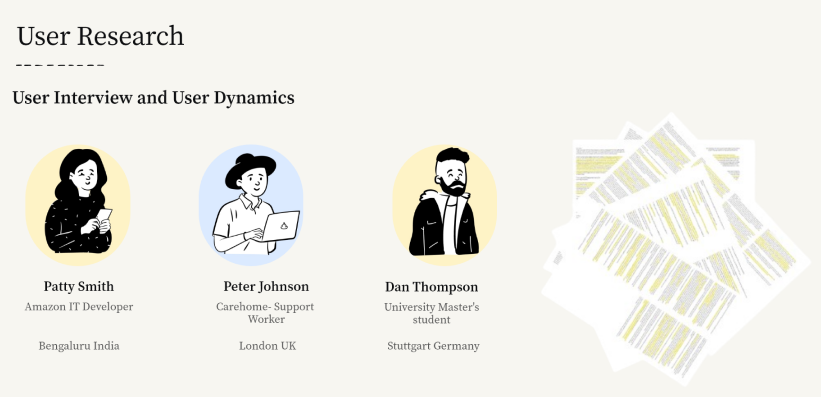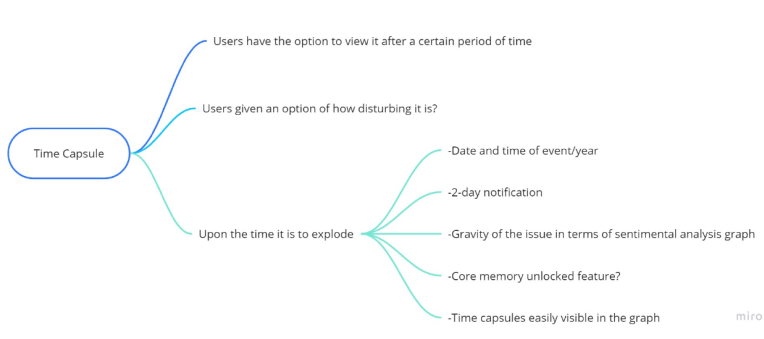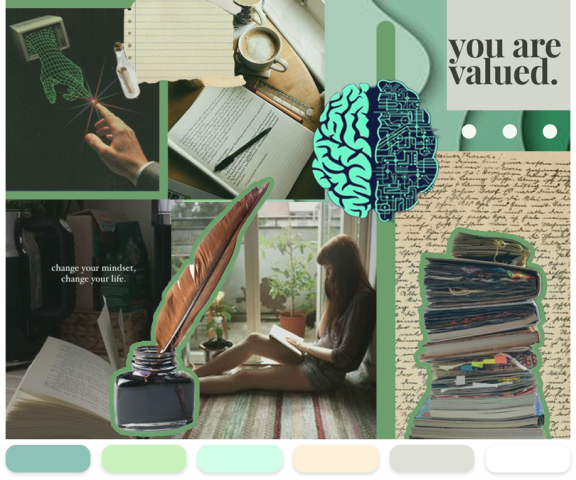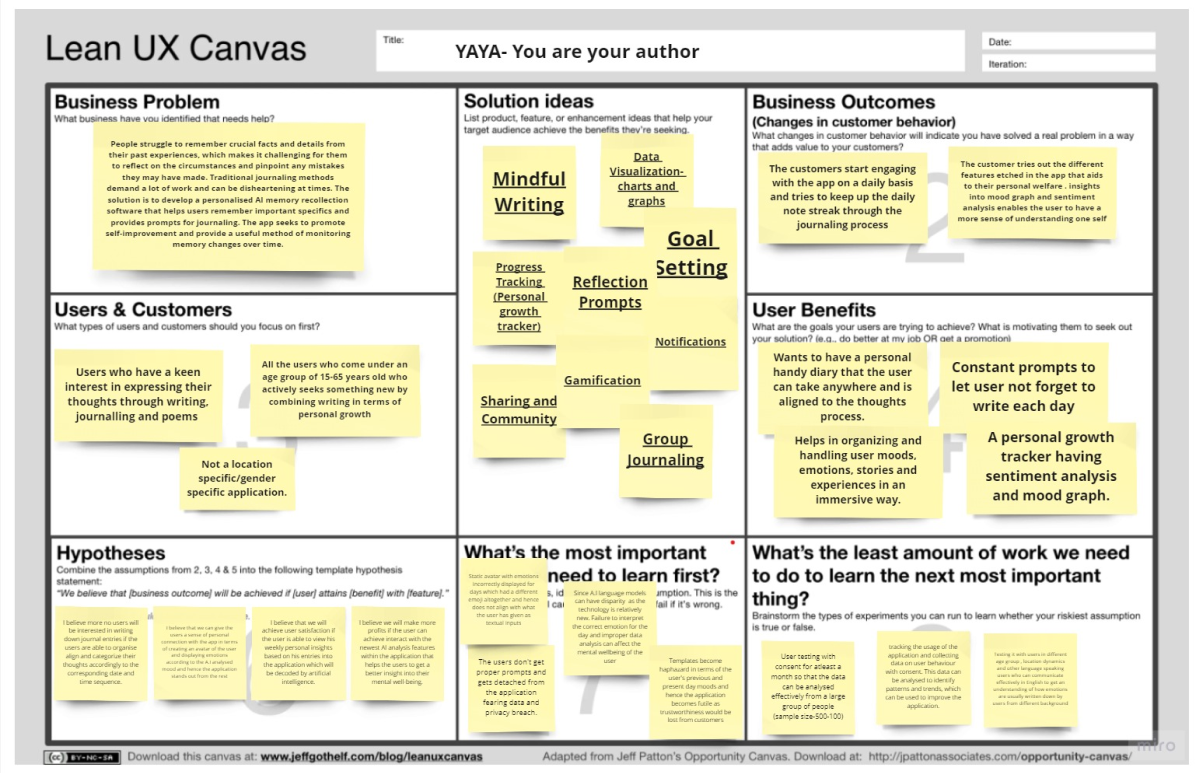YAYA
you are your author
An immersive experience journaling cum memory recollection app.





Introduction
In today’s fast-paced world, self-expression takes many forms—from words to images to numbers. Whether it’s sharing daily adventures on social media or keeping tabs on fitness progress with selfies and trackers, people find unique ways to communicate. But amidst this digital age, the age-old practice of journaling remains invaluable.
Now, with digital diaries and apps, recording life’s moments has never been easier. These tools not only help track experiences but also foster personal growth through reflection.
Imagine a personalized AI-powered journaling app that not only helps recall past experiences but also guides users in introspection. With tailored prompts and suggestions, this app promises an immersive journey of self-discovery and growth. It’s not just about keeping memories; it’s about understanding oneself better and evolving over time.
Aim
An immersive experience journaling cum memory recollection app. The key is to find ways to enhance the journaling experience and make it more engaging, interactive, and impactful for the user.
Objectives


- Enhancing Daily Journaling and Writing with Mindful Prompts
Help users engage more with daily journaling and writing processes with daily prompts so that a state of mindfulness and thoughtfulness is achieved.
- Immersive Journaling Data Visualisation
- AI-Driven Insights: Enhancing Data Interpretation for Personal Growth
Provide users with more enhanced data interpretations based on AI-modelled analysis of users’ dairy input and journaling.
- Progress Tracking and Goal setting
- Memory Recollection
Offering users detailed information and specific journal entries from their past to help them reflect on both their past and present experiences, turning them into valuable learning opportunities.
- Personal growth tracker based on mood and sentiment analysis.
- Efficient Task and Goal Management for Enhanced Productivity
Help users achieve their tasks and goals so that they have a more organized means of day-to-day activities.
Objectives

Problem Statement
People have trouble recalling important information and details from their previous experiences, which makes it difficult for them to think back on the events and identify shortcomings they may have made. Traditional journaling techniques take a lot of effort and are sometimes discouraging. The way around this is to create a customised AI memory recollection app that aids users in remembering crucial details and offers prompts for journaling. The app aims at how we might aid in self-improvement and offer an efficient way to track memories and emotions over time.
Project Process

Lean UX, the design methodology behind YAYA’s MVP, offers a unique approach compared to traditional UX methods. It swiftly cycles through experiments and design sprints, guided by hypotheses and user/stakeholder feedback.
This dynamic process aims to rapidly iterate and refine designs, ensuring the best possible outcome for the product.
Research
Surveys and Pilot mode
Surveys and a pilot mode were initially used to carry out the project. The nuanced nature of how people engaged in writing and how they kept their journaling to themselves was better understood through surveys.





Competitor Analysis


User Research and interviews
The pilot phase involved reaching out to individuals from diverse backgrounds to discuss journaling features.
Contacts were gathered from relatives, friends, and acquaintances. Key interview participants were selected based on relevant feedback. Research questions were formulated, and interviews were scheduled after participants completed ethical forms and based on their availability.


The users had been selected based on their involvement in journalling and hence users from different location dynamics and working conditions were chosen accordingly.
Think
Assumptions


Ideation
Features-Brainstorming
In terms of setting up and designing the journaling app, some features aligned with the Personal Growth and mindful writing that were brainstormed as a part of the ideation techniques were as follows.


What to do when you don’t want to remember something?
Time Capsule: Creating a feature that allows users to write entries that will only be visible to them in the future, such as in 5, 10, or 20 years. This could be a fun way for users to reflect on their past and see how much they’ve changed over time.
Crazy 8 And Brain Writings

Features Prioritising Charts Based on Moscow.


Mental Models

Proto- Persona
The overall study findings and statements from the user interview were collated, analysed, conceptualised, and aligned under the following key factors in order to create the personas.
The following considerations were taken into account
- Personality
- Skills
- Demographics
- Pain points and frustrations
- Behaviour and habits
- Needs and goals.


Hypothesis
Hypothesis Creation Chart

Hypothesis statements
- We believe we will make the users more curious if the emotional and sentiment analysis using AI features is implemented according to the users’ input texts.
- We believe that we will achieve regular engagement with the application among the users if the feature daily note streak in the form of a gamification process is regularly maintained by the user.
- We believe that we can give a personalized platform for the user so that through the account creation the user can have his own private space within the application.
- We believe that we can give a personalized platform for the user so that through the account creation the user can have his own private space within the application.
- We believe more no users will be interested in writing down journal entries if the users are able to organise align and categorize their thoughts accordingly to the corresponding date and time sequence.
- We believe that we will attract more users if the user has a hassle-free use of the application if personalized ease of access journey is provided across the platform.
- We believe that we will achieve user satisfaction if the user is able to view his weekly personal insights based on his entries into the application which will be decoded by artificial intelligence.
- We believe that we can gain more trustworthiness if the user data and inputs are highly encrypted and it’s a more one-to-one experience to enhance his/her personal mental state.
- We believe that we can enhance the journaling experience of the users by allowing users to superimpose digital information, journal entries, photos, or other digital content onto the physical environment making it easier to recall and reflect on memories and experiences.
- We believe that we can give the users a sense of personal connection with the app in terms of creating an avatar of the user and displaying emotions according to the A. I analysed the mood and hence the application stands out from the rest.
- We believe that we can generate more profit by making some of the features which excite the users in terms of subscription models.
- We believe we will achieve user retention by making the application interesting in a way that highlights a memory time capsule feature that the user will be able to edit, view and destroy according to his/her choice.
Hypothesis statements
- We believe we will make the users more curious if the emotional and sentiment analysis using AI features is implemented according to the users’ input texts.
- We believe we will make more profits if the user can achieve interact with the newest AI analysis features within the application that helps the users to get a better insight into their mental well-being.
- We believe that we will achieve regular engagement with the application among the users if the feature daily note streak in the form of a gamification process is regularly maintained by the user.
- We believe more no users will be interested in writing down journal entries if the users are able to organise align and categorize their thoughts accordingly to the corresponding date and time sequence.
- We believe that we can give a personalized platform for the user so that through the account creation the user can have his own private space within the application.
- We believe that we will attract more users if the user has a hassle-free use of the application if personalized ease of access journey is provided across the platform.
- We believe that we will achieve user satisfaction if the user is able to view his weekly personal insights based on his entries into the application which will be decoded by artificial intelligence.
- We believe that we can give the users a sense of personal connection with the app in terms of creating an avatar of the user and displaying emotions according to the A. I analysed the mood and hence the application stands out from the rest.
- We believe that we can gain more trustworthiness if the user data and inputs are highly encrypted and it’s a more one-to-one experience to enhance his/her personal mental state.
- We believe that we can generate more profit by making some of the features which excite the users in terms of subscription models.
- We believe that we can enhance the journaling experience of the users by allowing users to superimpose digital information, journal entries, photos, or other digital content onto the physical environment making it easier to recall and reflect on memories and experiences.
- We believe we will achieve user retention by making the application interesting in a way that highlights a memory time capsule feature that the user will be able to edit, view and destroy according to his/her choice.

Make
Lo-Fi Paper Prototype

Mid-Fi Wireframes

Mid Fi- Wire Flows
The wire flow was created as a flowchart so that users could more easily visualise the routes they take. Here is a list of the steps users take to complete a task, the path they follow within the application, and how they can navigate it. The screens have been split into-
- Login Screen
- Onboarding Screen
- Avatar Selection Screen
- Settings Screen
- Home page screen
- Present-day Inward page
- Journaling page – Media Entry Screens
- Map
- Memories Created Screens
- Day Rating Screen
- Emotion and mood analysis Screen
Mid-Fi Wireframes

Mood Board and Logo Design


The original concept was to combine elements of artificial intelligence with those of human emotion in the logo design. This was because the idea was such a fusion between a language processing model and human emotion characteristics combined. As a result, following numerous brainstorming sessions, a machine merged with the human brain was created. The focus later shifted to book paper and pens because the idea was all about keeping a personal journal. Later, an iteration of the pen was added to the book in the form of a diary, which had a circuit on the cover that represented the merging of the brain and machine.
The original concept was to combine elements of artificial intelligence with those of human emotion in the logo design. This was because the idea was such a fusion between a language processing model and human emotion characteristics combined. As a result, following numerous brainstorming sessions, a machine merged with the human brain was created.
The focus later shifted to book paper and pens because the idea was all about keeping a personal journal. Later, an iteration of the pen was added to the book in the form of a diary, which had a circuit on the cover that represented the merging of the brain and machine.
Styleguide and Components Library

High Fi Prototype
High Fi Prototype (Major Screens)


Check
Usability Testing.
To further evaluate the hypothesis statements and gain insight into how the features and purposes of the application were aligned, a usability testing method using Microsoft Teams remote was used to interview participants. The interview was performed on the specified date and time and in accordance with all industry standards.
To further evaluate the hypothesis statements and gain insight into how the features and purposes of the application were aligned, a usability testing method using Microsoft Teams remote was used to interview participants.
The interview was performed on the specified date and time and in accordance with all industry standards.


Hypothesis evaluation




Hypothesis evaluation




Final Version of the Lean UX Canvas

The process was enlightening and motivating due to its departure from traditional methods.
Lean UX facilitated rapid progress, focusing on MVP creation, efficiency, and iterative enhancements based on user feedback.
Creative problem-solving was key, enhancing critical thinking and adaptability. The gained knowledge holds future value, making the experience enjoyable and thought-provoking.
The process was enlightening and motivating due to its departure from traditional methods. Lean UX facilitated rapid progress, focusing on MVP creation, efficiency, and iterative enhancements based on user feedback. Creative problem-solving was key, enhancing critical thinking and adaptability. The gained knowledge holds future value, making the experience enjoyable and thought-provoking.
Strengths
- This application stands out for its unique use of Artificial Intelligence to analyze users’ emotions, moods, and sentiments through their personal journal entries, making it distinct in the market.
- User engagement through writing about their ideas and experiences is central to the application’s goal of promoting mental health and mindfulness. Personalization based on emotions allows users to assess their lives over time.
- With user-generated content driving insights into emotional patterns, the app can offer coping mechanisms such as prompts or short stories, thereby enhancing emotional well-being.
- Through weekly mood monitoring and analysis, users gain insights into their emotions and triggers, fostering self-awareness and clearer thinking.
- Features like streaks and regular prompts encourage consistent journaling as part of users’ daily routines.
- The app also provides tools for users to track memories and experiences, including story analysis, multimedia, location data, weather updates, and day ratings.
- Visual elements like mapping notes by location, date, and time aid memory organization for users who struggle with recall and organization
Weakness
- Due to the focus on creating a minimum viable project, certain features initially planned during ideation were not implemented, indicating the need for future development.
- Personalized journals analyzed by AI often require access to extensive personal data to provide tailored recommendations, feedback, and emotional analysis, raising privacy concerns, particularly if third-party services are involved in data storage or processing.
- To address privacy concerns, the use of third-party services should be limited, with preference for localized solutions, and clear guidelines should be established and communicated to users prior to registration.
- AI algorithms, still evolving, may exhibit biases and generate recommendations based on flawed premises, insufficient data, or misinterpretation of emotions, potentially leading to inaccurate or misleading advice.
- Furthermore, AI-based journals may lack the human touch necessary for providing moral support and guidance, as some users may struggle to connect with machine-modeled avatar characters and prefer interaction with a live person.
Future Works
During the ideation phase, various aspects for future development were outlined. The creation of an MVP product followed Lean UX principles, resulting in the elimination of numerous features. Further research is needed on the following key points:
- Upon release, exploration of a goal-setting and budget management component editable by users.
- Animation features for user avatars remain to be developed alongside additional avatar creation methods, including those utilizing facial recognition and offering customization options.
- Time constraints and methodological limitations prevented the development of the time capsule feature, despite its creative potential.
- Further investigation is necessary for AR journaling, which involves users attaching notes to specific locations and accessing them as memory capsules via AR features.
- Implementation of regular reminders and notifications, personalized by AI, could profoundly influence user reflection and navigation through life, potentially through integration with a customized AI chatbot.
- Integration of blockchain technology into YAYA could enhance privacy, security, and functionality, but requires additional research for implementation.



